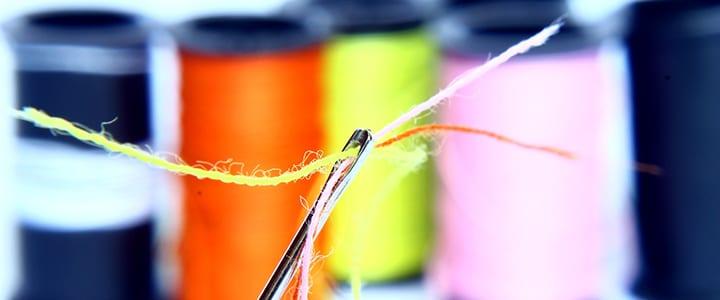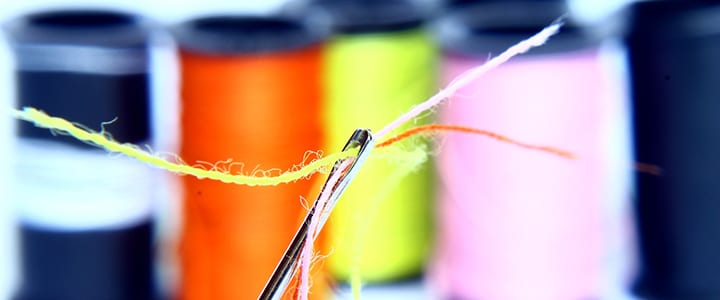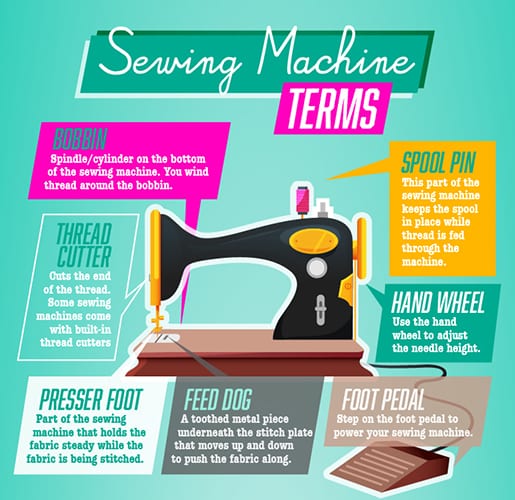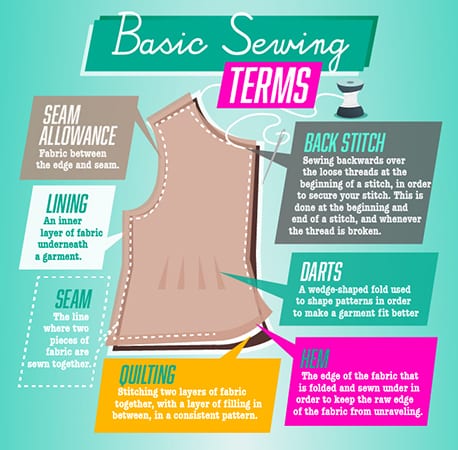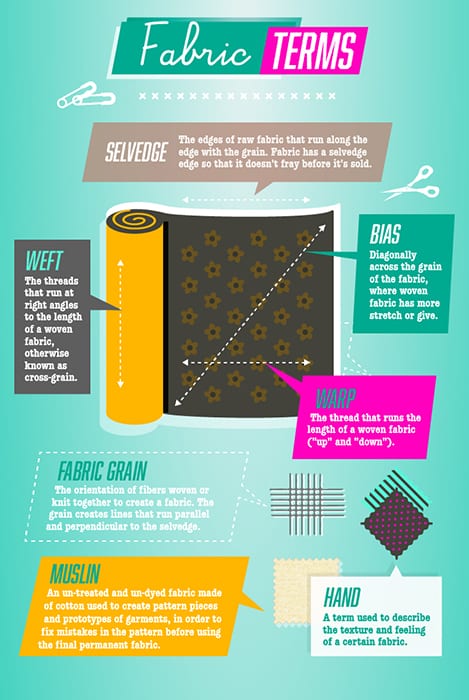Just as with learning any new skill or hobby, when it comes to sewing, you’re going to be faced with a ton of sewing terms. Before threading your needle and diving right into your sewing projects, it’s a good idea to learn some of the most popular sewing words and phrases. Whether you’re focusing on certain sewing tools or discovering different techniques, understanding sewing terminology can give you a strong foundation, making it easier for you to progress.
Maybe you’ve heard the sewing saying, “May your bobbin always be full!” Most recognize what this quote means, but you might be thinking, “What on earth is a bobbin?” Bobbin, miter, selvedge– there is an extensive sewing vocabulary, but don’t worry; we have compiled a simple list for you to learn the essential sewing terms. Check out our sewing glossary featuring some of the most basic sewing terms, and be sure to refer back to this handy guide anytime you need a refresher.
From Appliqué to Zig-zag, class is in session. Welcome to sewing 101!
Sewing Machine Terms
Whether it’s your first time sewing on a machine, or you’ve been using one for years, you might not know the name of all the parts on your sewing machine – or even what they do! All sewing machines have the same basic parts, and once you know them, you’ll have an easier time troubleshooting or addressing any issues with your machine. So here’s an introduction to basic sewing machine terms.
Foot Pedal: Step on the foot pedal to power your sewing machine.
Presser Foot: This is NOT the same as the foot pedal on the floor that you step on to make your sewing machine work. This is the part of the sewing machine that holds the fabric steady while the fabric is being stitched. It can be pulled up and down, off the fabric, with a lever or a button.
Hand Wheel: Use the hand wheel to adjust the needle height.
Spool Pin: This part of the sewing machine keeps the spool in place while the thread is fed through the machine.
Thread Cutter: Some sewing machines come with built-in thread cutters. As the name implies, this cuts the end of the thread.
Feed Dog: The toothed metal piece underneath the stitch plate that moves up and down to push the fabric along.
Basic Sewing Terms
In order to start wrapping your head around this fun new hobby, you’ll want to familiarize yourself with some basic sewing terms. Understanding these terms will help you read patterns, follow instructions, and talk about what you’re doing with a better vocabulary. From back stitches to seam allowances, we make sense of it all for you below.
Here are a few sewing phrases that will help you learn to sew.
Back Stitch: The process of sewing backward over the loose threads at the beginning of a stitch in order to secure your stitch. This works by securing the threads down so they don’t come loose and unravel your stitch. This is done at the beginning and end of a stitch, and whenever the thread is broken.
Seam: The line where two pieces of fabric are sewn together.
Seam Allowance: The space of fabric between the edge and seam. The seam allowance may be different depending on the type of fabric you use.
Lining: An inner layer of fabric underneath a garment.
Hem: The edge of the fabric that has been folded and sewn under in order to keep the raw edge of the fabric from unraveling and being seen.
Darts: A wedge-shaped fold used to shape sewing patterns in order to make a garment fit better.
Quilting: The process of stitching two layers of fabric together, with a layer of filling in between in a consistent pattern.
Check out this infographic to learn more about the basic sewing stitches.
Sewing Terms: Fabric Types
You can’t sew without fabric, so you’ll want to get to know all the different kinds of materials available to you. In fact, when it comes to starting a new project, your material will be one of the first decisions you make. Knowing the difference between warp and weft, how to find the grain, and when to use muslin will give you the step up that you need to go from beginner to pro sewist. Once you nail these sewing terms, you’ll be all set to take on a variety of sewing projects.
Fabric Grain: The orientation of fibers, woven or knit together, to create a fabric. The grain creates lines that run parallel and perpendicular to the selvedge.
Bias: Diagonally across the grain of the fabric, where woven fabric has more stretch or give.
Warp: The thread that runs the length of a woven fabric (“up” and “down”).
Weft: The threads that run at right angles to the length of a woven fabric, otherwise known as cross-grain.
Muslin: an untreated, undyed fabric made of cotton, used to create pattern pieces and prototypes of garments, in order to fix mistakes in the pattern before using the final permanent fabric.
Selvedge: The edges of a raw fabric that run along the edge with the grain. Fabric has a selvedge edge so that it doesn’t fray before it’s sold.
Hand: A term used to describe the texture and feel of a certain fabric.
Sewing Words and Phrases
The art and practice of sewing come with a huge vocabulary. There are many different kinds of sewing tools, stitches, fabric elements, and techniques associated with sewing.
Appliqué: The process of sewing a piece of fabric onto another piece of fabric, sewing close to the edges of the shape that you attach.
Baste: Sewing, by hand or machine, with long stitches in order to temporarily hold together two pieces of fabric, so that they stay in place while you stitch them together.
Binding: Using a thin strip of fabric or bias tape in order to hide the edges of a piece of fabric.
Embroidery: A hand-sewing technique used to decorate fabric with needle-made designs. Sewists generally use colorful thread, and you can also embroider fabric with a programmable sewing machine.
Facing: Fabric used to finish raw edges of a garment to make the edges lie flat. You can see this on a neckline or armhole.
Gather: A gather is created by running a thread along the fabric, and then scrunching the fabric together along the thread.
Pleat: A fold created by doubling the fabric over itself, and stitching it together.
Ruche: A pleated or gathered strip of fabric.
Seam Ripper: A small tool with a pointed edge used to remove stitches from a piece of fabric.
Sewing Notion: an item that is sewn or attached to a finished sewing project, such as a button or snap. This term can also describe a tool used for sewing, like a pin or a seam ripper.
Yoke: A design element at the top part of a garment, to fit over the body.
Zig Zag: A stretchable sewing machine stitch that runs diagonally, back and forth (zig and zag).
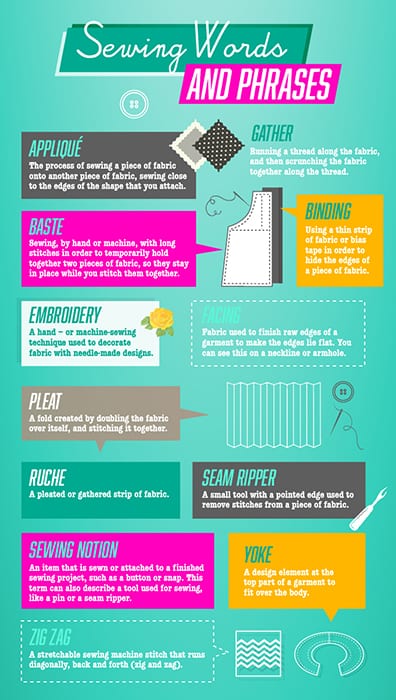
I hope this sewing vocabulary lesson helps you understand some of the basic sewing terms and phrases. If you learn them and use them often, you will sound like an old sewing pro in no time!
To help you review, here’s an infographic with all of the sewing vocabulary and phrases.
Sign Up for Sewing Lessons Today!
Once you’ve reviewed our sewing glossary with some of the most popular sewing terms and phrases, it’s time to put what you know into practice. But if you’re looking for more guidance, you can find other resources on sewing for beginners and sign up for TakeLessons in-person or online sewing lessons. With the help of a private instructor, you’ll get the hang of sewing before you know it. Whether you are a beginner touching a sewing machine for the first time or a more advanced sewer looking for a good challenge, our lessons can help. Sign up with us today!
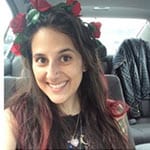 Post Author: Nikki D.
Post Author: Nikki D.Nikki teaches art, art history, and sewing lessons in Columbus, OH. She studied integrated fashion design at Parsons School of Design and is also certified in meditation science and techniques. Learn more about Nikki here!
Maile Proctor
